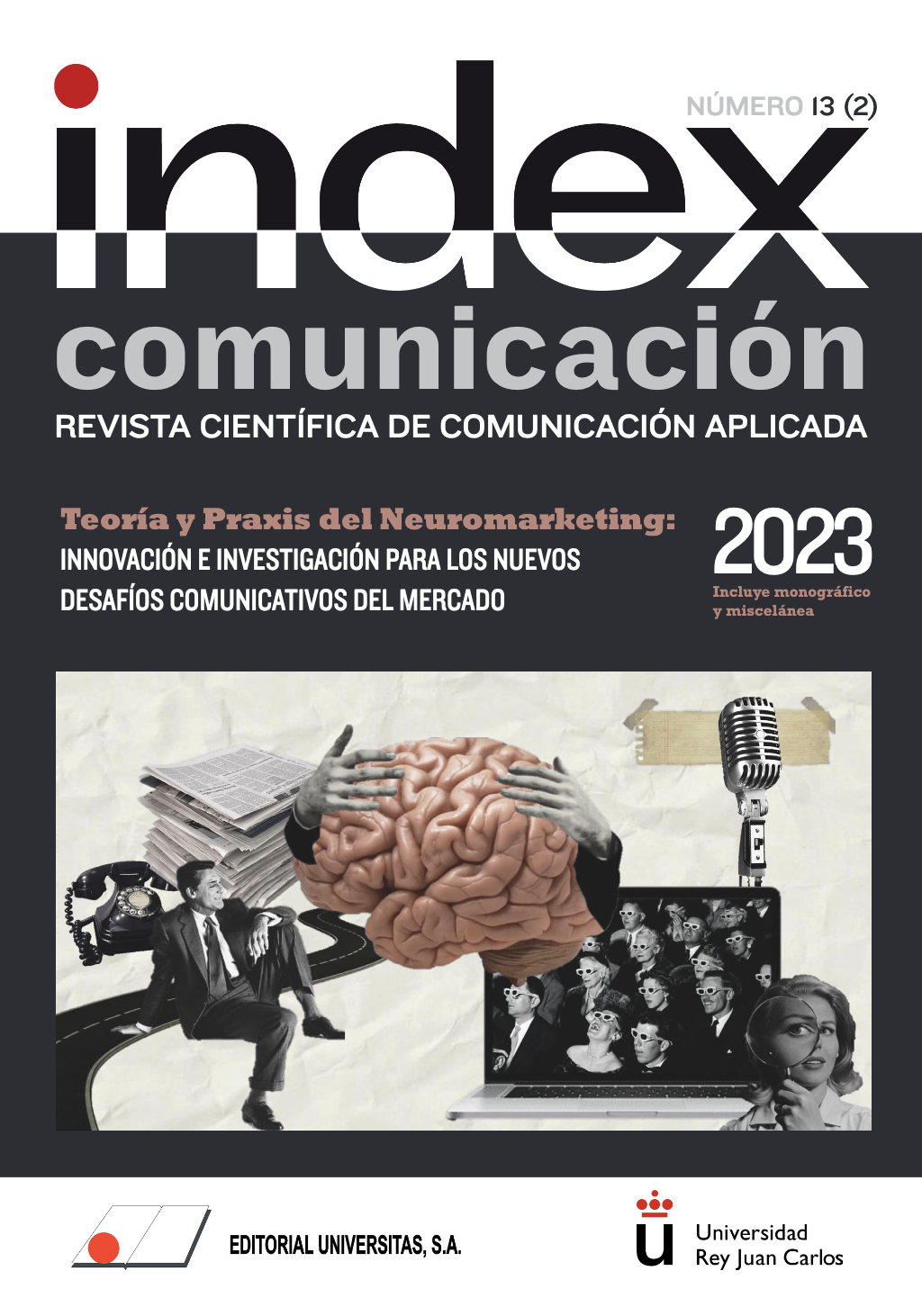Neuromarketing and Artificial Intelligence: the Case of Cruzcampo's Campaign 'With a Strong Accent'
DOI:
https://doi.org/10.33732/ixc/13/02NeuromKeywords:
Neuromarketing, Artificial Intelligence, Advertising campaigns, Branding, Brand imageAbstract
Since neuroscience broke into the field of marketing at the beginning of the 21st century, it has been proven that consumers base a large part of their daily decisions on their feelings, based on stimuli that move them rather than solely relying on conscious and rational factors. The research presents a case analysis of an award-winning Spot that uses artificial intelligence as the basis of the creative idea. Its objective is to assess the extent to which the implementation of this resource is pertinent in eliciting emotions, influencing brand awareness and perception, and fostering a favorable attitude towards the brand. For the analysis, a neuromarketing technique has been used, the Implicit Association Test, complemented with in-depth interviews and a CAWI survey. The results suggest that the use of AI in the creation of advertising messages favors the generation of positive attitudes toward the brand since it enhances the strength of the message transmitted, but it does not seem to influence the brand image or the intention to consume it.
Metrics
References
AYALA SÁNCHEZ, A. Y MARTÍNEZ VINZONEO, DANIEL (2013). Análisis de los resultados del Test de Asociación Implícita de la elección presidencial mexicana de 2012. Revista Justicia Electoral, 1(12), 59-99. Disponible en: https://bit.ly/3Jwure6
BATRA, R. Y KELLER, L. (2016). Integrating marketing communications: new findings, new lessons, and new ideas. Journal of Marketing, 80, 122-145. https://doi.org/10.1509/jm.15.041
BRAIDOT, N. (2009). Neuromarketing en acción ¿Por qué tus clientes te engañan con otros si dicen que gustan de ti? Granica.
COCA, A. (2010). Neuromarketing: las emociones y el comportamiento de compra. Perspectivas, 25, 9-24.
https://www.redalyc.org/articulo.oa?id=425942454003
COURT, D., ELZINGA, D., MULDER, S. Y VETVIK, O. J. (2009). The consumer decision journey. McKensey & Company. Disponible en http://bit.ly/3J1A83s
CRUZCAMPOTV (21 DE ENERO DE 2021). Así se hizo #ConMuchoAcento [video]. YouTube. https://youtu.be/BQLTRMYHwvE
DAFONTE-GÓMEZ, A. (2014). Claves de la publicidad viral: de la motivación a la emoción en los vídeos más compartidos. Comunicar, 22(43), 199-207.
https://doi.org/10.3916/C43-2014-20
DOOLEY, R. (2010). Brandwashing? Neuroscience Marketing. Disponible en https://bit.ly/3SFRhmH
EKMAN, P. (1992). An argument for basic emotions. Cognition and emotion, 6(3-4), 169-200.
https://doi.org/10.1080/02699939208411068
FORTUNATO, V. C. R., GIRALDI, J. D. M. E. Y OLIVEIRA, J. H. C. D (2014). A review of studies on neuromarketing: practical results, techniques, contributions, and limitations. Journal of Management Research, 6(2), 201-220.
https://doi.org/10.5296/jmr.v6i2.5446
GREENWALD, A. G., BRIAN A. N. AND MAHZARIN, R. B. (2003). Understanding and using the Implicit Association Test: I. An improved scoring algorithm. Journal of personality and Social Psychology, 2, 85, 197-216. Disponible en: https://bit.ly/3mNxTrZ
JARAMILLO VLADIMIR, S. (2021). El neuromarketing y el comportamiento del consumidor de cerveza. Revista de Investigación en Ciencias de la Administración ENFOQUES, 5(17), 65-77.
http://doi.org/10.33996/revistaenfoques.v5i17.106
HAMELIN, N., THAICHON, P., ABRAHAM, C., DRIVER, N., LIPSCOMBE, J., PILLAI, J. (2020). Storytelling, the scale of persuasion and retention: A neuromarketing approach. Journal of Retailing and Consumer Services, vol. 55, 102099.
https://doi.org/10.1016/j.jretconser.2020.102099
KAHNEMAN, D., (2011). Thinking fast, Thinking slow. Farrar, Straus and Giroux.
KIETZMANN, J., PASCHEN, J. Y TREEN, E. (2018). Artificial Intelligence in Advertising. How marketers can leverage artificial intelligence along the consumer journey. Journal of Advertising Research, 58(3), 263-267.
https://doi:10.2501/jar-2018-035
KOTLER, P. Y KELLER, K. L. (2008). A framework for marketing management. Pearson Prentice Hall.
LINDSTROM, M. (2009). A lógica do consumo: Verdades e mentiras sobre por que compramos. Nova Fronteira.
LUPA-WÓJCIK, I. (2020). Emotions aroused by the most popular content on Facebook and their virtuality on the example of selected industries. 7th European Conference on Social Media ECSM 2020, Larnaca.
NOOR, K. B. M. (2008). Case study: a strategic research methodology. American Journal of Applied Science, 5(11), 1602-1604.
https://doi.org/10.3844/ajassp.2008.1602.1604
PALOMO-DOMÍNGUEZ, I. (2021). Del mito a la viralidad. El caso de la campaña de Cruzcampo que resucitó a Lola Flores. aDResearch ESIC, 26, 28-48. https://doi:10.7263/adresic-026-02
PELAU, C.; ENE, I. Y POP, M. I. (2021). The impact of artificial intelligence on consumers’ identity and human skills. Amfiteatru Economic, 56, 33-45.
https://dx.doi.org/10.24818/EA/2021/56/33
PLUTCHIK, R. (1982). A psychoevolutionary theory of emotions. Social Science Information, 21(4-5), 529-553.
https://doi.org/10.1177/053901882021004003
PREMIOS EFICACIA (2021). Cruzcampo, con mucho acento, Gran Premio Eficacia 2021. Recuperado el 3 de marzo de 2022 de http://bit.ly/3mNxTrZ
ROZAN, V.C., ENGRACIA, J.M., CALDEIRA DE OLIVEIRA, J.H. (2014). A Review of Studies on Neuromarketing: Practical Results, Techniques, Contributions and Limitations. Journal of Management Research, 6, 2, 201-220. https://doi.org/10.5296/jmr.v6i2.5446
SEBASTIÁN-MORILLAS, A., MUÑOZ-SASTRE, D., & NÚÑEZ-CANSADO, M. (2020). Importancia de la estrategia de comunicación y su relación con el insight para conseguir la eficacia publicitaria: el caso de España. Cuadernos.Info, (46), 249–280. https://doi.org/10.7764/cdi.46.1786
TOSI, J. D., LEDESMA, R. D., POÓ, F. M., MONTES, S. A., & LÓPEZ, S. S. (2018). El test de asociaciones implícitas (Implicit Association Test). Una revisión metodológica. Revista Iberoamericana de Diagnóstico y Evaluación - e Avaliação Psicológica, 1(46), 175-187. Disponible en: http://bit.ly/4020YhK
WILSON, R., GAINES, J. Y HILL, R. P. (2008). Neuromarketing and consumer free will. Journal of Consumer Affairs, 42(3), 389-410.
http://dx.doi.org/10.1111/j.1745-6606.2008.00114.x
YIN, R. (1993). Application of case study research. Sage Publications, 42(3), 33-35.
Published
How to Cite
Issue
Section
License
Copyright (c) 2023 Sonia-Aránzazu Ferruz-González, Pavel Sidorenko Bautista, Cristina Santos López (Autor/a)

This work is licensed under a Creative Commons Attribution-NonCommercial 4.0 International License.
Authors who submit to this journal agree to the following terms:
Authors retain copyright and ensure the magazine's right to be the first publication of the work as licensed under a Creative Commons Attribution-NoComercial 4.0 International License that allows others to share the work with an acknowledgment of authorship of the work and the initial publication in this magazine, with no commercial purpose.
Authors can establish separate additional agreements for non-exclusive distribution of the version of the work published in the magazine (for example, to an institutional repository or publish it in a book), with an acknowledgment of its initial publication in this journal.
It allows and authors are encouraged to disseminate their work electronically (eg, in institutional repositories or on their own website) prior to and during the submission process, as it can lead to productive exchanges, as well as a citation more early and most of the published work (See The Effect of Open Access).















